- The importance of proper watering for orchids
- 1. Finding the right watering schedule
- 2. Understanding the needs of your orchid
- 3. Avoiding overwatering
- 4. Utilizing the right watering method
- 5. Monitoring the health of your orchid
- Understanding the different types of orchids and their water requirements
- 1. Phalaenopsis Orchids
- 2. Cattleya Orchids
- 3. Dendrobium Orchids
- 4. Oncidium Orchids
- 5. Paphiopedilum Orchids
- Determining the right watering schedule for your orchids
- 1. Understand the natural habitat of your orchid
- 2. Check the moisture levels in the growing media
- 3. Observe the orchid’s leaves and roots
- 4. Develop a watering routine based on your observations
- 5. Adjust the watering schedule based on seasonal changes
- Choosing the right watering method for orchids
- 1. Watering with the immersion method
- 2. Watering with the spray method
- 3. Watering with the bottom watering method
- 4. Watering using an automatic watering system
- Best practices for watering orchids
- Signs of overwatering and underwatering in orchids
- Signs of overwatering
- Signs of underwatering
- Troubleshooting common watering issues for orchids
- Overwatering:
- Underwatering:
- Water quality:
- Temperature and humidity:
- Watering frequency:
- Q&A:
- Why are my orchid’s leaves turning yellow?
- How often should I water my orchid?
- What is the ideal way to water orchids?
- How do I know if my orchid is getting enough water?
- Should I mist my orchid?
- Video: Knowing this secret, you can propagate from any orchid
Orchids are beautiful and exotic flowers that require specific care to thrive. One of the most important factors in orchid care is proper watering. Getting the watering routine right can be a challenge for beginners, as orchids have different water needs compared to other houseplants. It’s crucial to strike a balance between underwatering, which can lead to dehydration, and overwatering, which can cause root rot.
When it comes to watering orchids, it’s essential to consider factors such as the type of orchid, the potting medium, and environmental conditions. Orchids are epiphytes, which means they naturally grow on trees and absorb moisture from the air and rainwater. To mimic their natural habitat, it’s crucial to provide adequate moisture without leaving the roots in standing water.
To water orchids properly, it’s best to follow the soak-and-dry method. This technique involves thoroughly wetting the orchid’s roots and potting medium, allowing excess water to drain away, and then letting the roots dry out before watering again. With this method, the orchids get the moisture they need without risking root rot or dehydration.
Another important aspect of watering orchids is understanding when to water. Rather than sticking to a fixed watering schedule, it’s better to check the moisture level of the potting medium and the orchid’s roots. One way to determine if an orchid needs watering is by evaluating the weight of the pot. If it feels light, it’s a sign that the orchid is ready for water. Additionally, you can use a wooden stick or a moisture meter to assess the moisture levels in the potting medium.
In conclusion, mastering the art of watering orchids is essential for ensuring their health and longevity. By understanding the specific water needs of orchids, following the soak-and-dry method, and monitoring the moisture levels, beginners can successfully care for these stunning flowers and enjoy their beauty for years to come.
The importance of proper watering for orchids
Proper watering is essential to the health and well-being of orchids. As beautiful and delicate plants, orchids require a careful balance of moisture to thrive. The right amount of water can help orchids achieve optimal growth and vibrant blooms, while too little or too much water can lead to problems such as root rot or dehydration.
1. Finding the right watering schedule
One of the most important aspects of orchid care is finding the right watering schedule. Orchids are epiphytes, meaning they naturally grow on trees and derive nutrients from the air and rainwater. They are used to periods of wetness followed by dryness. To replicate this environment, it is recommended to water orchids only when the potting medium is dry to the touch.
2. Understanding the needs of your orchid
Not all orchids have the same watering requirements. Different species and hybrids have different moisture needs depending on their native habitats. Some orchids prefer a drier environment and need less frequent watering, while others thrive in more humid conditions and require more frequent watering. Understanding the specific needs of your orchid will help you establish an appropriate watering routine.
3. Avoiding overwatering
Overwatering is one of the most common mistakes beginners make when caring for orchids. It is essential to avoid leaving orchids sitting in standing water, as this can lead to root rot and fungal diseases. Instead, water orchids thoroughly and allow any excess water to drain away. Emptying the saucer or cache pot after watering can help prevent waterlogged conditions.
4. Utilizing the right watering method
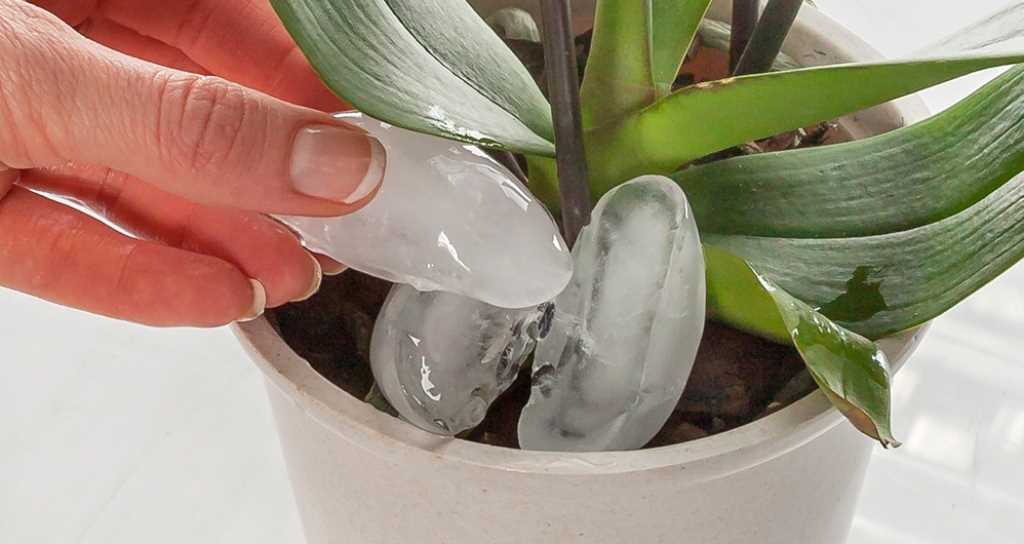
There are different methods you can use to water orchids, and the choice will depend on factors such as the type of orchid, the potting medium used, and your own preferences. Some common watering methods include soaking the pot in water, pouring water over the potting medium until it drains freely, or misting the roots. It is important to choose a method that allows the water to reach the roots without causing damage or excessive moisture.
5. Monitoring the health of your orchid
Regularly monitoring the health of your orchid can help you identify any watering issues. Signs of overwatering include yellowing or wilting leaves, a foul odor, or soft and mushy roots. On the other hand, underwatering can result in shriveled or wrinkled leaves and dry, brittle roots. By paying attention to these signs, you can make adjustments to your watering routine to ensure the health and vitality of your orchid.
In conclusion, proper watering is crucial for the well-being and success of orchids. By understanding the needs of your orchid, establishing a suitable watering schedule, avoiding overwatering, utilizing the right watering method, and monitoring the health of your plant, you can provide the ideal moisture conditions for your orchid to thrive and produce stunning blooms.
Understanding the different types of orchids and their water requirements
When it comes to watering orchids, it’s important to understand that different types of orchids have different water requirements. While some orchids prefer a regular watering schedule, others prefer to dry out between waterings. Here are some of the most common types of orchids and their water requirements:
1. Phalaenopsis Orchids
Phalaenopsis orchids, also known as moth orchids, are one of the most popular types of orchids. They require regular watering, but the key is to let the roots dry out slightly between waterings. This usually means watering once every 7-10 days, depending on the humidity and temperature of your environment.
2. Cattleya Orchids
Cattleya orchids are known for their showy blooms and fragrant scent. They prefer a bit more water than Phalaenopsis orchids, but they also need to dry out between waterings. Water them thoroughly and allow the potting medium to dry out about halfway before watering again.
3. Dendrobium Orchids
Dendrobium orchids come in many different varieties, but they all have similar water requirements. They need to be watered more frequently while they are actively growing and producing new shoots, but they prefer to dry out between waterings during their dormant period. The frequency of watering can vary depending on the specific variety of Dendrobium orchid.
4. Oncidium Orchids
Oncidium orchids, also known as dancing lady orchids, have pseudobulbs that store water and nutrients. They prefer to dry out slightly between waterings, so water them thoroughly and allow the potting medium to dry out before watering again. During the active growth period, they may require more frequent watering.
5. Paphiopedilum Orchids
Paphiopedilum orchids, also known as slipper orchids, have unique water requirements. They prefer to stay slightly moist at all times, so water them regularly but be careful not to overwater. Allow the potting medium to dry out slightly between waterings.
It’s important to note that these are general guidelines and individual orchids within each type may have slightly different water requirements. Always observe your orchids closely and adjust your watering schedule accordingly. Additionally, factors such as humidity, temperature, and potting medium can also affect the watering needs of orchids.
A good way to check if your orchid needs water is to stick your finger about an inch into the potting medium. If it feels dry at that depth, it’s time to water. However, if it still feels damp, wait a bit longer before watering again.
Determining the right watering schedule for your orchids
Watering orchids can be tricky, as these beautiful plants have specific needs in terms of moisture. Finding the right watering schedule for your orchids is essential for their health and proper growth. Here are some tips to help you determine the best watering routine for your orchids:
1. Understand the natural habitat of your orchid
Orchids come from different regions around the world, and their natural habitats can vary widely. Some orchids thrive in humid tropical conditions, while others prefer drier environments. Understanding the natural habitat of your orchid will give you a better idea of its watering needs.
2. Check the moisture levels in the growing media
The easiest way to determine if your orchid needs watering is by checking the moisture levels in the growing media. Stick your finger about an inch into the potting medium – if it feels damp, then your orchid doesn’t need watering yet. If it feels dry, it’s time to water.
3. Observe the orchid’s leaves and roots
The condition of your orchid’s leaves and roots can also give you valuable clues about its watering needs. If the leaves are wrinkled or limp, it could be a sign of underwatering. On the other hand, yellow or mushy leaves may indicate overwatering. Similarly, healthy roots are plump and green, while dead or rotted roots are brown and mushy.
4. Develop a watering routine based on your observations
Once you’ve observed your orchid’s natural habitat, checked the moisture levels in the growing media, and evaluated its leaves and roots, you can start developing a watering routine. Keep in mind that orchids generally prefer a drying-out period between waterings to prevent root rot. This means that you should water your orchid only when the potting medium is almost dry.
5. Adjust the watering schedule based on seasonal changes
The watering needs of orchids can change throughout the year as they go through different growth stages. During the active growing season, usually spring and summer, orchids may require more frequent watering. In contrast, during the dormant period in fall and winter, their watering needs decrease. Adjust your watering schedule accordingly to ensure your orchids receive the right amount of moisture.
Remember that each orchid is unique, and it may take some trial and error to find the perfect watering routine. By paying attention to your orchid’s natural habitat, monitoring the moisture levels in the growing media, and observing the condition of its leaves and roots, you’ll be able to determine the right watering schedule to keep your orchids happy and healthy.
Choosing the right watering method for orchids
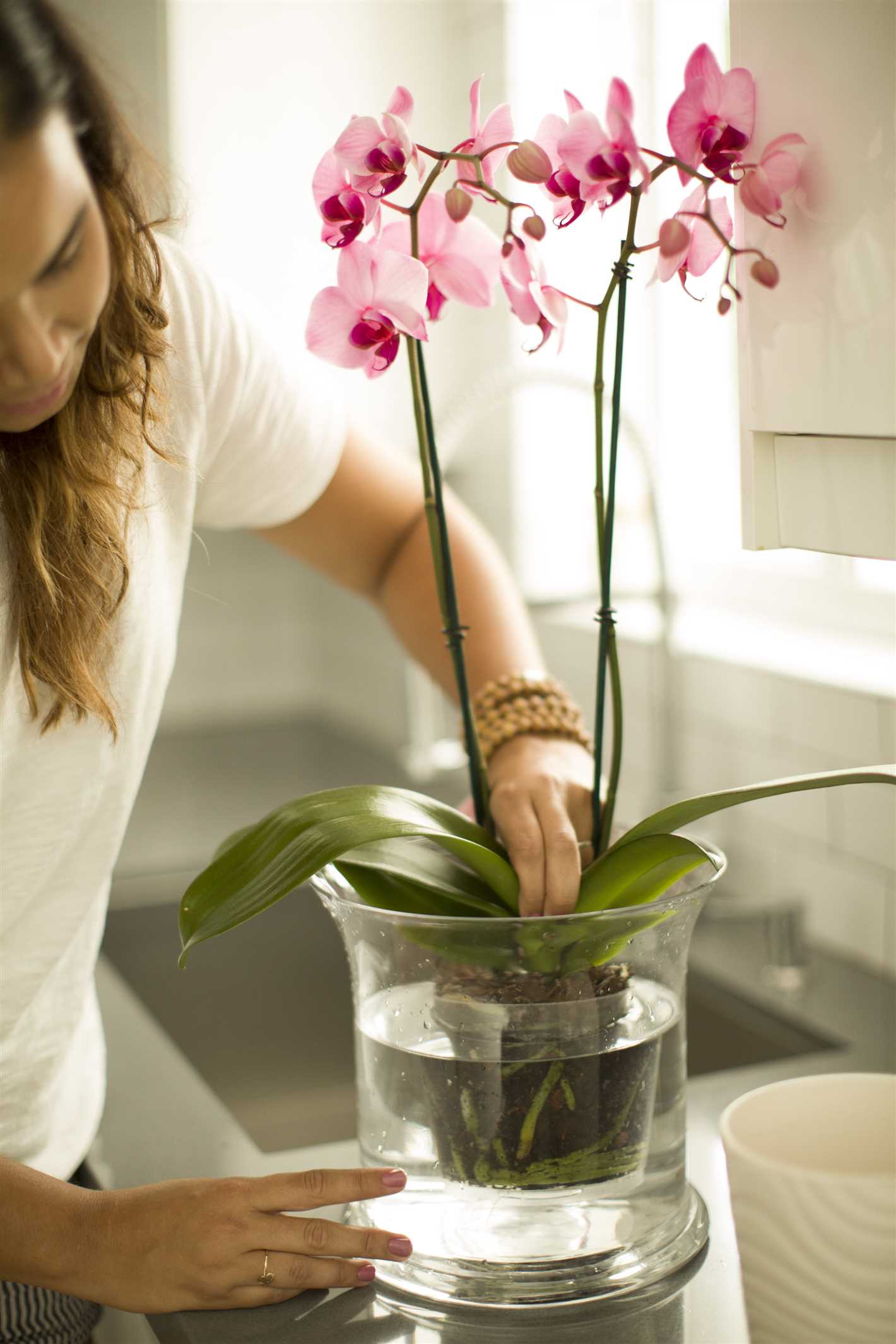
Watering orchids can be a bit tricky, as they are not like typical houseplants. They have unique water requirements that need to be properly fulfilled in order to keep them healthy and thriving. When it comes to watering orchids, choosing the right method is crucial to avoid overwatering or underwatering, which can lead to root rot or dehydration.
1. Watering with the immersion method
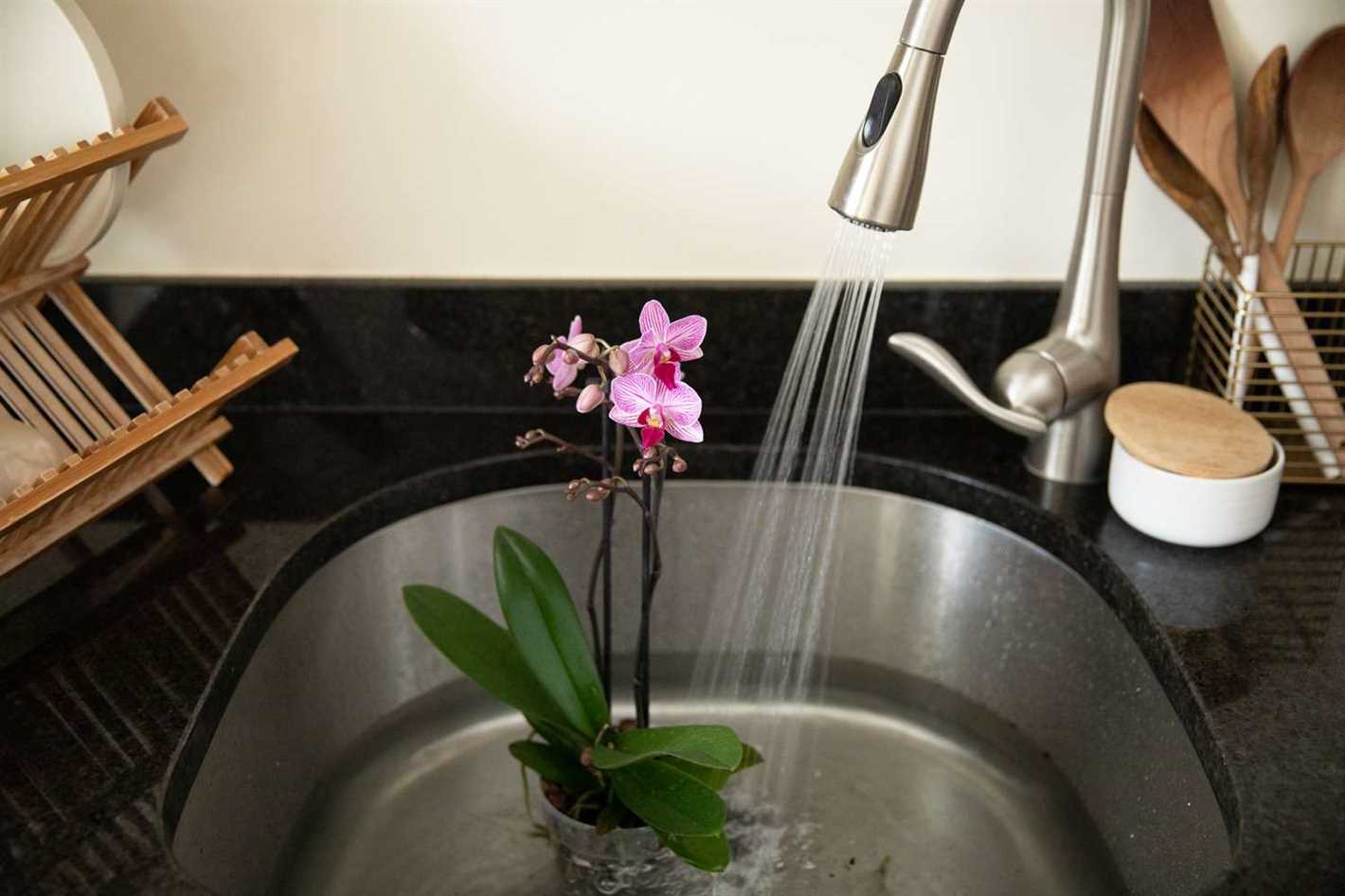
The immersion method, also known as the soak and dry method, is one of the most common and effective ways to water orchids. Here’s how it works:
- Fill a basin or container with tepid water.
- Submerge the orchid’s pot into the water, making sure that the water level reaches just below the rim of the pot.
- Let the orchid soak in the water for about 15-30 minutes, or until the potting medium is thoroughly moistened.
- Remove the orchid from the water and allow excess water to drain out completely.
This method allows the orchid roots to absorb water thoroughly while preventing the plant from becoming waterlogged.
2. Watering with the spray method
The spray method is suitable for orchids with aerial roots or those mounted on a piece of bark or a cork slab. Here’s how to water orchids using the spray method:
- Fill a spray bottle with room temperature or slightly warm water.
- Spray the orchid’s roots and potting medium lightly until they are slightly damp.
- Avoid spraying water directly on the leaves or flowers, as it can cause fungal diseases.
This method mimics the misting and rainfall orchids receive in their natural habitats.
3. Watering with the bottom watering method
The bottom watering method is ideal for orchids potted in containers with drainage holes. Here’s how to do it:
- Place the orchid pot in a saucer or tray filled with water.
- Allow the potting medium to soak up the water through the drainage holes for about 15-30 minutes.
- Remove the pot from the water and let any excess water drain out completely.
This method ensures that the orchid’s roots are adequately hydrated while preventing the potting medium from getting waterlogged.
4. Watering using an automatic watering system
If you have a large collection of orchids or need to carefully control the watering process, using an automatic watering system can be a convenient option. These systems usually involve a timer, drip irrigation, or a misting system that can provide consistent and controlled watering for your orchids.
Before choosing an automatic watering system, make sure to research and select the one that suits your orchid’s specific needs and your level of expertise.
Remember, regardless of the watering method you choose, it is important to observe your orchids closely and adjust the watering frequency based on their individual needs. Monitoring the moisture level of the potting medium and avoiding overwatering or underwatering will help your orchids thrive and bloom beautifully.
Best practices for watering orchids
Watering orchids can be a bit tricky, as they have specific needs that vary depending on the type of orchid and its growing conditions. Here are some general guidelines to follow:
- 1. Understand your orchid’s water requirements: Different orchids have different preferences when it comes to water. Some orchids, like Phalaenopsis, prefer to dry out slightly between waterings, while others, like Paphiopedilum, like to stay evenly moist. Research the specific needs of your orchid to ensure you are providing the right amount of water.
- 2. Use the right watering method: The most common method for watering orchids is to soak them in water for a short period of time, allowing the roots to absorb the moisture. This can be done by placing the orchid pot in a sink or basin filled with room temperature water for about 15-30 minutes. Alternatively, you can use the drench and dry method, where you thoroughly water the orchid and then allow the pot to drain completely before watering again.
- 3. Water in the morning: Orchids prefer to dry out before nightfall, so it is best to water them in the morning to allow any excess water on the leaves or in the growing medium to evaporate throughout the day.
- 4. Avoid overwatering: Overwatering is one of the most common causes of orchid death. It is important to avoid letting the roots sit in standing water, as this can lead to root rot. Only water the orchid when the top inch of the growing medium feels dry to the touch.
- 5. Consider the potting medium: The type of potting medium you use will affect how often you need to water your orchid. Orchids potted in bark or moss-based mixtures tend to dry out more quickly and may require more frequent watering, while those potted in sphagnum moss hold onto moisture longer and may need less frequent watering.
- 6. Use filtered or distilled water: Orchids are sensitive to minerals and chemicals found in tap water, so it is best to use filtered or distilled water. Alternatively, you can let tap water sit out for 24 hours before using it to allow the chlorine to dissipate.
- 7. Observe your orchid: Pay attention to the condition of your orchid and adjust your watering schedule accordingly. If the leaves are wrinkled or the roots are shriveled, it may be a sign that the orchid is not getting enough water. On the other hand, if the leaves are yellowing or the roots are turning brown, it may be a sign of overwatering.
- 8. Maintain humidity: Orchids thrive in humid environments, so it is important to maintain the right levels of humidity. You can do this by placing a tray of water near the orchid, using a humidifier, or misting the leaves with water.
- 9. Consider the season: Orchids have different water requirements during different seasons. In general, orchids may require more frequent watering during the warmer months and less frequent watering during the cooler months.
- 10. Don’t forget about fertilizer: Orchids need more than just water to thrive. Be sure to regularly fertilize your orchid according to the instructions provided, as this will help provide essential nutrients for healthy growth.
By following these best practices for watering orchids, you will be on your way to successfully nurturing these beautiful plants.
Signs of overwatering and underwatering in orchids
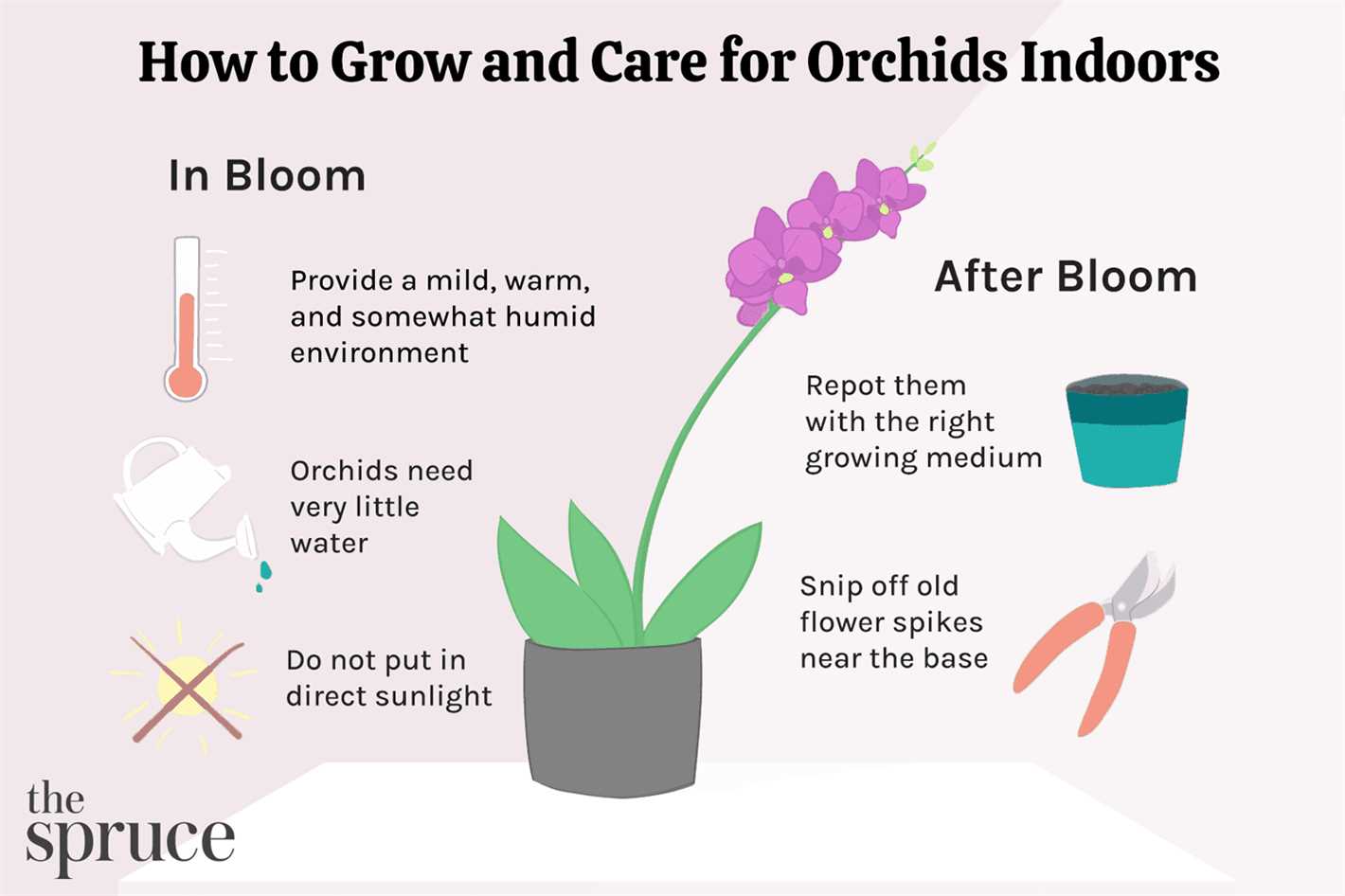
Knowing when to water your orchids is important for their health and well-being. Overwatering and underwatering are common mistakes that can be detrimental to orchid growth. Here are some signs that indicate whether your orchid is being overwatered or underwatered:
Signs of overwatering
- Yellowing leaves: If the leaves of your orchid are turning yellow, especially at the base, it may be a sign of overwatering. Overwatering can lead to root rot, which in turn affects the health of the leaves.
- Soft and mushy roots: Overwatering can cause the roots of an orchid to become soft and mushy. Healthy orchid roots should be firm and white or greenish in color.
- Foul odor: If you notice a foul odor coming from your orchid potting mix, it could be a sign of overwatering. This odor is often caused by stagnant water and can indicate that the roots are rotting.
- Black spots on leaves: Overwatering can also lead to the development of black spots on the leaves of your orchid. These spots are often a sign of fungal or bacterial infection, which thrive in moist conditions.
Signs of underwatering
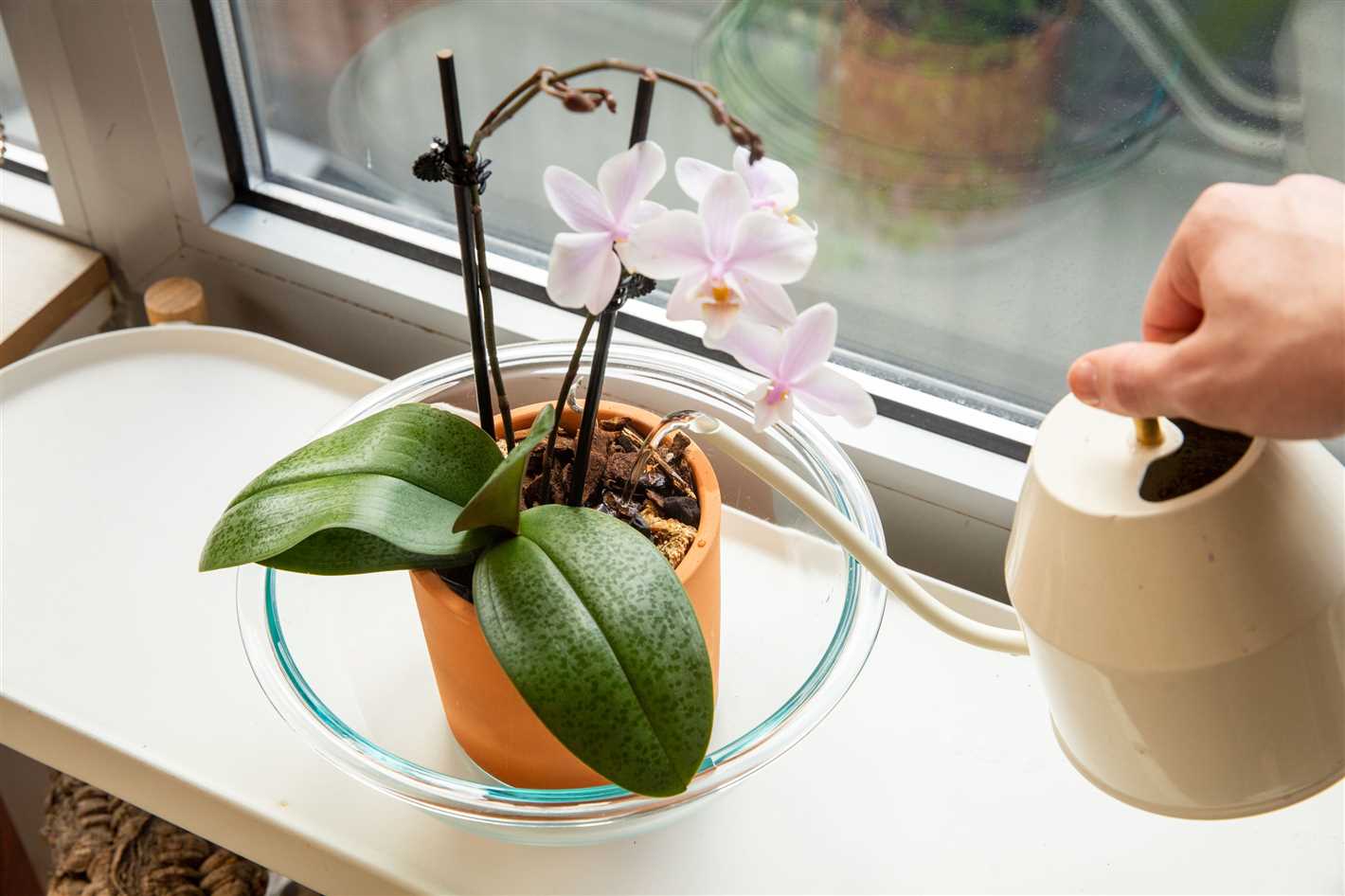
- Wrinkled and shriveled leaves: If your orchid’s leaves are wrinkled or shriveled, it may be a sign of underwatering. Orchids need a consistent supply of water, and if they do not receive enough, the leaves can become dehydrated.
- Dry potting mix: If the potting mix of your orchid feels dry to the touch, it may indicate that your orchid is not receiving enough water. However, it’s important to note that orchids prefer to dry out slightly between waterings, so the potting mix should not be continuously wet.
- Limp or drooping leaves: When an orchid is underwatered, its leaves may appear limp or droopy. This is the plant’s way of conserving moisture and reducing water loss.
- Slow growth: Underwatered orchids may exhibit slow growth or fail to produce new leaves or blooms. Water is essential for the photosynthesis process, so a lack of water can hinder the orchid’s overall growth and development.
By observing these signs, you can better determine the water needs of your orchids and adjust your watering routine accordingly. Remember that finding the right balance is key to keeping your orchids healthy and thriving.
Troubleshooting common watering issues for orchids

Watering orchids can be a delicate process, and sometimes issues may arise that can affect the health and well-being of your plants. Here are some common watering problems for orchids and how to troubleshoot them:
Overwatering:
Overwatering is one of the most common issues with orchids. It can lead to root rot and other fungal diseases. Signs of overwatering include yellowing leaves, mushy roots, and a foul odor. To fix this problem:
- Ensure that the potting mix is well-draining and not waterlogged.
- Reduce the frequency of watering and allow the top inch of the potting mix to dry out before watering again.
- Consider repotting the orchid into a fresh potting mix if the roots are severely damaged.
Underwatering:
Underwatering can also harm orchids, causing dehydration and wilting. Signs of underwatering include wrinkled leaves, dry potting mix, and a lack of growth. To address this problem:
- Check the moisture level of the potting mix regularly and water the orchid when the top inch of the mix feels dry.
- Water thoroughly to ensure that the entire root system receives moisture.
- Consider placing the orchid pot in a tray of water for a short period to allow it to soak up the water from the bottom.
Water quality:
The quality of water used for orchids can also impact their health. Orchids are sensitive to chemicals such as chlorine and fluoride found in tap water. To improve the water quality:
- Use filtered or distilled water for watering your orchids.
- Allow tap water to sit overnight to allow the chlorine to dissipate before using it to water your orchids.
- Avoid using softened water, as it contains salts that can harm the orchid’s roots.
Temperature and humidity:
The temperature and humidity levels in the orchid’s environment can also affect its watering needs. In a hot and dry environment, orchids may require more frequent watering. In a cooler and more humid environment, they may require less watering. Monitor the temperature and humidity levels and adjust your watering schedule accordingly.
Watering frequency:
The watering frequency can vary depending on various factors such as the type of orchid, potting mix, container size, and environmental conditions. It is essential to observe your orchid’s specific needs and adjust the watering frequency accordingly. Remember, it is better to underwater than overwater an orchid.
Q&A:
Why are my orchid’s leaves turning yellow?
The most common reason for yellowing leaves in orchids is overwatering. Orchids are susceptible to root rot, so it’s important to let their roots dry out between waterings. Another possible cause is underwatering or insufficient light.
How often should I water my orchid?
The frequency of watering depends on various factors such as the type of orchid, the medium it is planted in, the temperature, and humidity levels. In general, orchids should be watered about once a week or when the top inch of the potting medium feels dry. It’s important to let the orchid’s roots dry out between waterings to prevent root rot.
What is the ideal way to water orchids?
The ideal way to water orchids is to thoroughly soak the potting medium and let the excess water drain out completely. It’s best to use room-temperature water and avoid wetting the leaves. Orchids prefer to be watered early in the day, allowing any moisture on the leaves to dry before nighttime.
How do I know if my orchid is getting enough water?
One way to tell if your orchid is getting enough water is by checking the potting medium. If it feels dry to the touch about an inch below the surface, it’s time to water. Another indicator is the weight of the pot – a dry orchid will be lighter, while a watered orchid will feel heavier. Additionally, healthy orchids have firm and plump pseudobulbs.
Should I mist my orchid?
Misting can be beneficial for orchids, especially if you have a low humidity environment. However, misting should not replace regular watering. Orchids need to be watered thoroughly and allowed to dry out between waterings. Misting can be done in addition to watering to increase humidity around the plant.
Video:
Knowing this secret, you can propagate from any orchid







